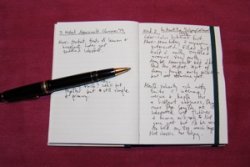All About Wine Tasting Notes

Taking wine tasting notes are critical to the full appreciation of fine wine. I know of no better way to maximize the experience you attain from each wine tasting experience. When learning how to taste wine you learn how to focus on the various components of each wine. Your notes, ideally in a wine tasting journal, help to refine your palate, to get the most out of each wine, to communicate your impressions to others and even to remember what you tasted.
Now, for some of us, the thought of taking notes sounds like work. It brings back bad memories of school and taking tedious notes on a lecture. However, wine tasting notes are different. We aren't talking about a chore here! After all, tasting wine should be fun! But it can also be educational and it can help improve your ability to assess wines in the future.
Why take wine notes?
When we do anything we generally retain only a small percentage of what he see, hear, smell or taste. For example, when reading a book, listening to a lecture or participating in a conversation, we can only recall specifics about a tiny portion of what passed our senses. Part of this is a lack of concentration on the minutia and subtleties. Another part is simply a lack of an ability to memorize everything. However, there are some ways to improve this retention and to be able to focus more clearly on subtle nuances of the experience. One of these is taking notes.
The very act of taking a wine tasting note, of putting into words our sensory experience, helps us to focus clearly on the wine in question. Without taking notes, people tend to sniff the wine, taste the wine and swallow the wine. They develop an overall impression of the wine but many of the details, the subtle nuances, go right past them without notice. By putting those sensations into words we are focusing more completely on the experience and analyzing it while we are experience it.
Additionally, writing down these experience helps you to remember the wine. The wines name, vintage, its characteristics and your impression of it are solidified by putting it into words and recording it. This also allows you to refer back to your notes at a later date if you wish.
What do typical wine tasting notes consist of?
A complete wine note usually consists of the following several sections. Not every note has to have the same level of depth and detail but it should generally touch on each of these sections at least superficially. Not every section will pertain to every wine and some tasters will prefer not to use some sections (such as rating or scoring). While the sections below go into great detail about each component, once you get more experienced with wine tasting, your wine tasting notes do not need to list each of these separately. You will learn what is important and will condense your notes, touching on each of these aspects as needed. This extensive list is simply a primer to get you accustomed to the types of things that you should be thinking about when enjoying a wine.
- Tasting Date - So that you can go back and find a wine you tasted or to know when you tasted a specific wine.
- Wine Information - This is simply the details about which wine you are tasting. Writing it down in your wine tasting note helps you remember the name of the wine and you can refer back to it at a later date.
- Wine Name - Besides the producer, some wines have a name. Sometimes this is simply the name of the specific vineyard that the wine came from and sometimes it is a proprietary name that the winery calls that specific blend.
- Producer - This is the winery, domaine, house or chateau that made the wine.
- Region/Appellation - This is the region in the world that the grapes were grown. Be as specific as possible. Try not to just list "France" or "California". Rather, list the specific region or appellation such as "Burgundy" or "Sonoma".
- Grape Varieties - Some wines are named for the principle grape variety (such as Cabernet Sauvignon or Merlot) but some, particularly European wines, are named for where they came from. If you know the grape varieties or if they are listed on the bottle (sometimes they are listed on the back label!) you can take note of the varietals as well as their respective percentages in the blend (wines can include several grapes blended together). This helps you to understand what type of wine it is and what you can expect from its flavor profile and character.
- Vintage - This is the year the grapes for the wine were grown. Most wines have the vintage listed on the label somewhere. Occasionally you will see Non-Vintage wines (abbreviated NV) which do not come from a single vintage. Instead, they are a blend of several vintages. This is most common with some sparkling wines and some types of fortified wines like Port and Sherry.
- Color and Appearance - While the color of a wine itself may not contribute significantly to the pleasure the wine brings you, it can tell you a lot about the wine in the glass before you even raise it to your nose or lips. In your wine tasting notes, comment on the color's hue, depth and clarity. To learn more about assessing a wine's color, see the Wine Color and Appearance page.
- Nose/Aroma - The wine aroma, often described as the wine's "nose" or bouquet, is one of the most important aspects to the appreciation of fine wine. The complexity, subtleties and character of a wine's bouquet can be striking. Many a wine I have sat and swirled just sniffing it for a long time before even bringing it to my lips. Describe the intensity and specific aromas you detect in the nose as well as any "off" aromas or flaws. Learn more about assessing a wine's aroma on the Wine Aroma page.
- Mouth/Flavors - The flavor and feeling of wine in your mouth is the culmination of the whole wine tasting ritual. Wine tasting notes should include an in depth description of the wine's flavor profile as well as things such as its sweetness, its body, its acidity and tannins (or the wine's structure), the mouthfeel, the balance (of each component in the wine) and the lingering finish or aftertaste. To learn more about how to assess a wine's flavor or "mouth" see the Wine Flavor page.
- Conclusions/Impressions/Food Pairing - After assessing each of the above individual components of the wine, a comment or two of wrap-up should give your overall impressions of the wine. Did you like it or not? Was it strikingly good or just ok? Did you think it was young or was it mature? Would you like to buy more of it if you could? Are there particular foods you think it would pair well with or which you sampled it with? Any general comments can be included as conclusion to wine tasting notes.
- Rating/Score - Not all wine enthusiasts like to rate wines by a scoring system. Some prefer to let the words and descriptors speak for themselves. Others thing that a simple score or rating gives a clear message about the overall quality of the wine.
There are several different scoring systems or rating scales that are used both in wine critic publications as well as in amateur wine taster's notes. The most common by far is the 100-point scale which rates wines from 50 to 100 points, the higher the better. Other scales include the 20-point scale and 3 or 5 star rating systems. Whether you use one of these scoring systems or even devise your own is up to you and what you are comfortable with. An example of how you might systematically go about scoring wines on the 100-point scale is as follows:
Points are awarded for each of 4 categories and then added to 50 to achieve the final score. The points listed below represent the maximum points given for each factor but anything from zero to that number can be awarded based on your assessment.
50 (if drinkable) + 5 (appearance) + 15 (nose) + 20 (mouth) + 10 (finish, other, general gestalt, etc.) = 100
Remember that wine tasting is a personal and subjective undertaking! There is no right or wrong. Everyone has different tastes. So just because a famous wine critic gives a wine a 97 point score (a very high score obviously) doesn't mean that it will be the type of wine you like. Styles and tastes vary. So your own grading scale is really a tool for your own assessment and to help communicate that assessment to fellow wine drinkers.
- Other info: Alcohol content, Price, Location of tasting - Wine tasting notes can include several other bits of information which may be useful. Wines vary considerably in their alcohol content. While many German Rieslings can be as low as 7% alcohol, some California Zinfandels can tip the scales at 17-18%. Fortified wines, like Sherry, Port and Madeira, can be even higher with around 18-20% alcohol by volume. You may also want to make note of the price for a wine to refer back to at a later date if you are considering buying some/more. Finally, listing the location of a tasting may help you remember the even, company and setting of the tasting.
Wine tasting journals
A wine tasting journal can be a very useful tool to help collect your wine tasting notes in one convenient location. Trust me, a pile of random pieces of scratch paper is no place for wine tasting notes, especially if you plan to ever be able to find your notes again. A journal, either one specifically designed for wine notes or a blank journal into which you transcribe your notes, can be handy in this respect and it makes you look like a real wine pro! To learn more, see the Wine Tasting Journal page.
Wine tasting notes templates
Some wine tasting journals have templates for wine tasting notes on each page which include sections for each of the components of the wine discussed above. Additionally, you can print out or type up sheets with these wine tasting notes templates for yourself or your guests at a wine tasting party. For more info, go to the Wine Tasting Notes Templates page.
Done with the Wine Tasting Notes page?
Return to the How to Taste Wine Page.

 Taking wine tasting notes are critical to the full appreciation of fine wine. I know of no better way to maximize the experience you attain from each wine tasting experience. When learning how to taste wine you learn how to focus on the various components of each wine. Your notes, ideally in a wine tasting journal, help to refine your palate, to get the most out of each wine, to communicate your impressions to others and even to remember what you tasted.
Taking wine tasting notes are critical to the full appreciation of fine wine. I know of no better way to maximize the experience you attain from each wine tasting experience. When learning how to taste wine you learn how to focus on the various components of each wine. Your notes, ideally in a wine tasting journal, help to refine your palate, to get the most out of each wine, to communicate your impressions to others and even to remember what you tasted.






